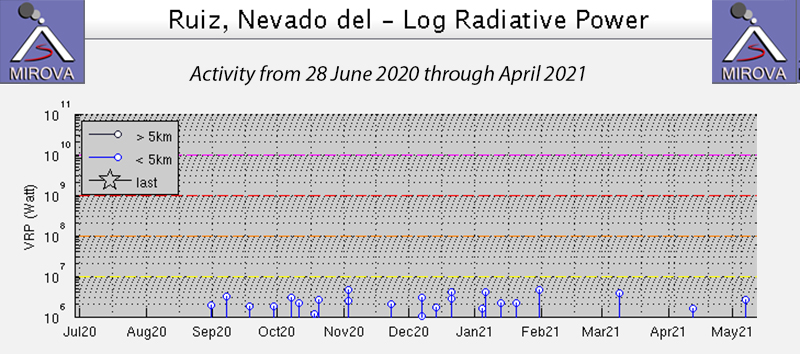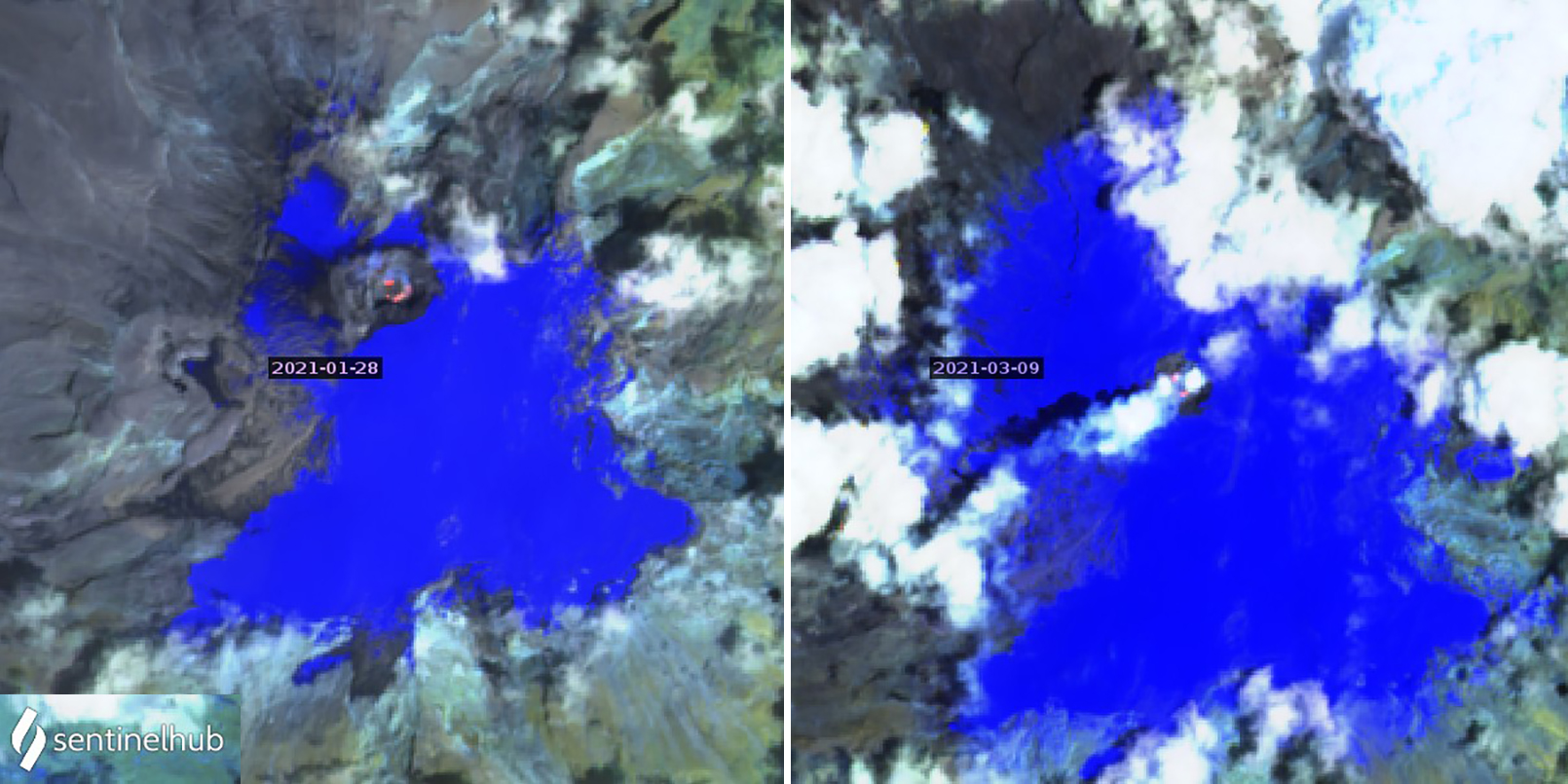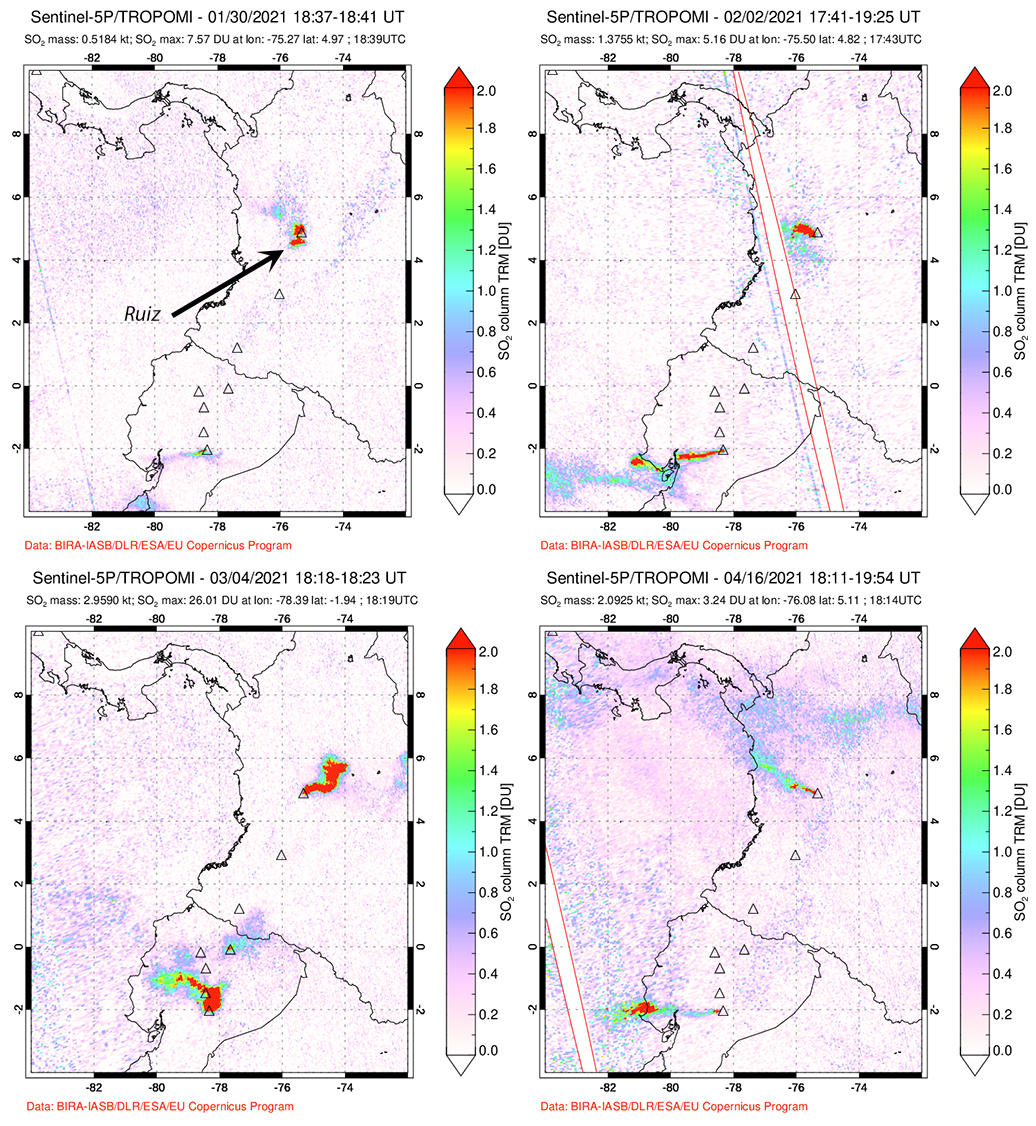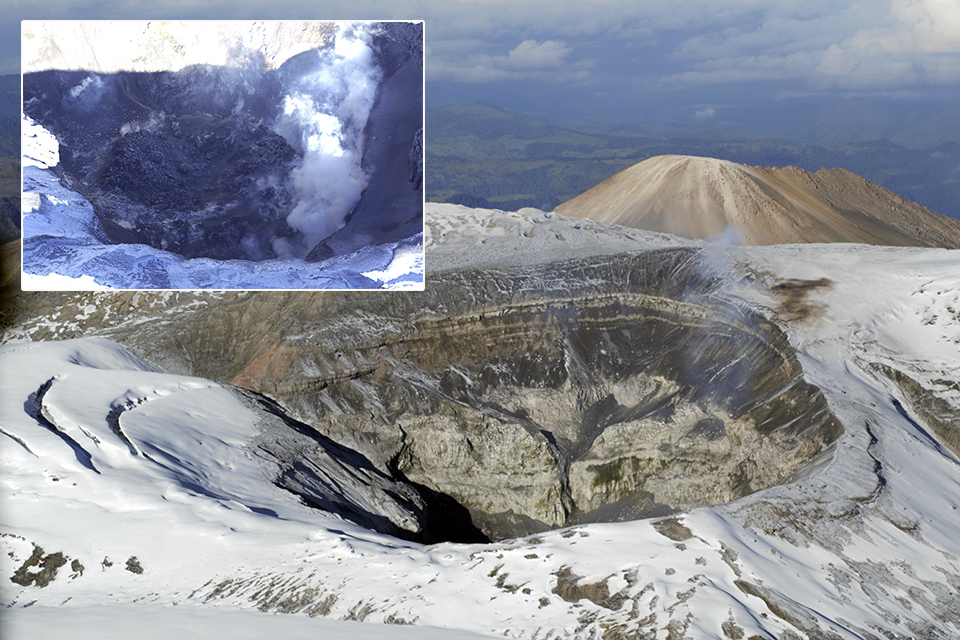Report on Nevado del Ruiz (Colombia) — June 2021
Bulletin of the Global Volcanism Network, vol. 46, no. 6 (June 2021)
Managing Editor: Edward Venzke.
Edited by A. Elizabeth Crafford.
Nevado del Ruiz (Colombia) Low-level thermal activity and dome growth continues during January-April 2021
Please cite this report as:
Global Volcanism Program, 2021. Report on Nevado del Ruiz (Colombia) (Crafford, A.E., and Venzke, E., eds.). Bulletin of the Global Volcanism Network, 46:6. Smithsonian Institution. https://doi.org/10.5479/si.GVP.BGVN202106-351020
Nevado del Ruiz
Colombia
4.892°N, 75.324°W; summit elev. 5279 m
All times are local (unless otherwise noted)
Colombia’s broad, glacier-capped Nevado del Ruiz has dated eruptions going back 8,600 years, including observed activity since 1570. Ruiz remained quiet for 20 years after the deadly September 1985-July 1991 eruption until new explosive activity occurred from February 2012 into 2013. Renewed activity beginning in November 2014 included ash and gas-and-steam plumes, ashfall, and the appearance of a slowly growing lava dome inside the Arenas crater in August 2015. Intermittent ash emissions and thermal evidence of dome growth continued with alternating periods of increased thermal and explosive activity during 2015-2020; SO2 emissions persisted at significant levels. This report covers ongoing activity from January-April 2021 using information from the Servicio Geologico Colombiano (SGC) and the Observatorio Vulcanológico y Sismológico de Manizales, the Washington Volcanic Ash Advisory Center (VAAC) notices, and satellite information.
Steam and gas emissions continued throughout January-April 2021, but ash emissions were infrequent and only confirmed visually during April. Thermal activity continued at a low level (figure 125); infrequent satellite data confirmed continued growth of the dome (figure 126). Sulfur dioxide emissions recorded daily by satellite instruments were weak in January and weak to moderate during February. A period of strong daily SO2 emissions in early March was followed by weak and moderate emissions for the rest of the month and during April 2021 (figure 127).
Overall activity was low during January 2021. The number and intensity of seismic Volcano-tectonic (VT) events related to rock fracturing decreased from December 2020. Low levels of tremor continued throughout the month, and there were two episodes of drumbeat seismicity interpreted by SGC as related to dome growth. The tallest steam and gas plume reached about 1.5 km above the rim of Arenas crater on 30 January, but no ash emissions were reported during the month. An overflight on 29 January revealed the continued slow growth of the dome inside the crater and minor emissions of gas and steam (figure 128).
Both the number of seismic events and the amount of energy released decreased again during February 2021 from the previous month. Most of the VT seismic events were related to rock fracturing in the immediate vicinity of the volcano. Low-level harmonic tremors were recorded during 4-5 February. Three short episodes of very low-energy drumbeat seismicity, between 3 and 33 minutes long, were recorded on 16, 19, and 22 February. On 26 February gas and steam plumes reached about 1.5 km above the crater rim. The Washington VAAC reported a possible ash emission on 21 February moving SE at 5.8 km altitude seen in the summit webcam, but weather clouds made the observation uncertain.
Seismicity related to both rock fracturing and fluid movement increased during March 2021, with events primarily within the Arenas crater and SE, SSW, and NW of the crater within a radius of 4 km. Episodes of drumbeat seismicity associated with rock fracturing (VT) and dome growth were recorded on 2-4, 14, 15, 17, and 26-28 March. On 26 March the highest daily rate of this type of seismicity occurred so far in 2021, with a total of 411 VT earthquakes distributed in 14 episodes. Most of the seismicity associated with fluid movement was located in the Arenas crater or around it, within a radius of 2 km. Harmonic tremor was recorded on 2, 7, 11, 12 and 13 March with durations of 20 to 55 min. All of the episodes were very low energy.
Visibility from the webcams was poor for much of the month due to strong precipitation and clouds. On 29 March 2021 the gas plume reached about 2.5 km above the crater rim. SGC noted that a few of the seismic signals related to the fluid movement inside the volcano were likely associated with emission of gas and possibly ash, although none were confirmed visually due to clouds. The Washington VAAC reported an ash emission on 19 March that rose to an altitude of 6.4 km and drifted N. A possible ash emission on 27 March rose to 6.1 km altitude and also drifted N, but extensive cloud cover obscured visibility.
Minor ash emissions and low-level thermal anomalies were reported during April 2021. Seismic activity (VT) decreased during April in both frequency and energy level compared with March. Episodes of drumbeat seismicity associated with rock fracturing were recorded on 2, 5, 14, 17, 19, 22-23, and 26-27 April. Drumbeats associated with fluid dynamics were recorded on 16 and 18 April. They were very low energy, and a few had longer durations than those recorded earlier in the year, ranging from 29-50 minutes. Harmonic tremor was recorded on 12, 13, and 19 April. On 20 April gas and steam reached more than 2 km above the crater. Webcams and field observers confirmed that seismic signals were associated with gas and ash emissions on 1, 16, 26, and 30 April. The Washington VAAC reported an ash emission on 1 April that rose to 5.8 km altitude and drifted SW. Ash emissions were also reported on 26 and 30 April that rose to 6.1 and 5.8 km altitude and drifted NW and N, respectively, for a few hours before dissipating.
Geological Summary. Nevado del Ruiz is a broad, glacier-covered volcano in central Colombia that covers more than 200 km2. Three major edifices, composed of andesitic and dacitic lavas and andesitic pyroclastics, have been constructed since the beginning of the Pleistocene. The modern cone consists of a broad cluster of lava domes built within the caldera of an older edifice. The 1-km-wide, 240-m-deep Arenas crater occupies the summit. The prominent La Olleta pyroclastic cone located on the SW flank may also have been active in historical time. Steep headwalls of massive landslides cut the flanks. Melting of its summit icecap during historical eruptions, which date back to the 16th century, has resulted in devastating lahars, including one in 1985 that was South America's deadliest eruption.
Information Contacts: Servicio Geologico Colombiano (SGC), Diagonal 53 No. 34-53 - Bogotá D.C., Colombia (URL: https://www.sgc.gov.co/volcanes); MIROVA (Middle InfraRed Observation of Volcanic Activity), a collaborative project between the Universities of Turin and Florence (Italy) supported by the Centre for Volcanic Risk of the Italian Civil Protection Department (URL: http://www.mirovaweb.it/); Sentinel Hub Playground (URL: https://www.sentinel-hub.com/explore/sentinel-playground); NASA Global Sulfur Dioxide Monitoring Page, Atmospheric Chemistry and Dynamics Laboratory, NASA Goddard Space Flight Center (NASA/GSFC), 8800 Greenbelt Road, Goddard, Maryland, USA (URL: https://so2.gsfc.nasa.gov/).





